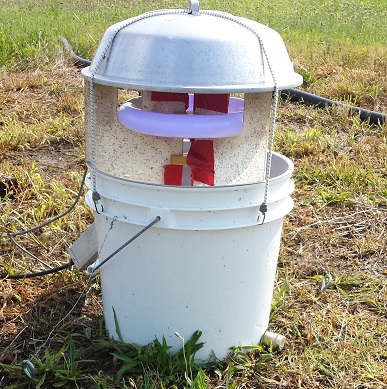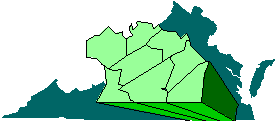Our scouts (Ed Seymore, Jamie Hogue, and Dr. Herbert’s Entomology team) have started sampling soybean fields across Virginia for kudzu bug and brown marmorated stink bug. The file attached at the end of this paragraph indicates the counties where kudzu bug has been found (blue counties = kudzu bug found in soybean; maroon counties = kudzu bug found on other hosts such as kudzu). Please note that we have not yet sampled all counties on our survey route. I will continue to provide weekly updates on this, including pest population levels, as the season progresses. KB_7_16_2015
Category Archives: Pest Group
Black light trap captures for the week ending July 16, 2015
Corn earworm moth catches from reporting stations were low this week. Nightly averages were: Warsaw=zero; Southampton (Courtland)=zero; Suffolk=0.4. Brown marmorated stink bug nightly averages were: Warsaw=zero; Southampton (Courtland)=1.3; Suffolk=zero. Thanks to the following for their reports this week: Mary Beahm, Austin Brown, and Dr. Herbert’s Entomology team. The image of the “bucket style” black light trap is courtesy of Austin Brown. 
Fungicide Resistant Frogeye Leaf Spot Present in Virginia
Fungicides are an important and effective tool for management of fungal diseases of crops including soybean. Unfortunately, over time fungal pathogens have the potential to develop resistance to specific fungicide modes-of-action. Mutations conferring resistance to fungicides are relatively rare, but multiple applications of the same fungicide chemistry impose selection pressure on pathogen populations and increase the frequency of those mutations over relatively short periods of time. Thus, specific fungicide chemistries have the potential to lose their effectiveness over time. Fungicide resistant isolates of Cercospora sojina, the causal agent of frogeye leaf spot in soybean, have recently been confirmed throughout the southeast including in North Carolina in 2013 and Virginia in 2014. In 2014, a small preliminary survey was conducted to determine if fungicide resistance is occurring in Virginia populations of frogeye leaf spot. Four fields were tested, and two of those fields had fungicide resistant strains. The resistance is specific to strobilurin (QoI, FRAC group 11) fungicides, which are highly effective for control of fungal foliar diseases but to which resistance can rapidly occur within fungal populations. Effective foliar disease management requires appropriate fungicide chemistry selection based on the specific pathogens present and their sensitivity to different fungicide modes of action.
Additional isolates of the frogeye leaf spot pathogen from throughout Virginia need to be collected and tested for fungicide resistance so that appropriate fungicide recommendations can be made. Other states have already initiated fungicide resistance monitoring programs for the causal agent of frogeye leaf spot (C. sojina), and we will implement a similar program in Virginia. Soybean leaves with symptoms of frogeye leaf spot will be collected throughout the 2015 growing season, the fungus will be isolated, and isolates will be tested for resistance to strobilurin (QoI) fungicides. If fungicide resistance is widespread in Virginia, recommendations for foliar fungicides and/or cultivar selection may need to be modified. If incidence of fungicide resistance is low, we will continue to monitor fungal populations and assess the risk of fungicide control failures on a year-by-year basis.
In order to implement an effective fungicide resistance monitoring program, we are requesting that leaf samples from soybean fields with symptoms of frogeye leaf spot (see pictures above) be submitted to the Tidewater AREC for testing. For more information on submitting samples, please contact Dr. Hillary Mehl (757) 657-6450 ext. 423 or hlmehl@vt.edu.
Black light trap report for the week ending July 9, 2015
This week, corn earworm moth captures in black light traps were zero at Warsaw, Suffolk, and Southampton. Brown marmorated stink bug catches (nightly averages) were 0.1 for Warsaw, zero for Suffolk, and 0.3 for Southampton. Thanks to Mary Beahm, Ames Herbert and crew, and Austin Brown for their reports this week.
Kudzu Bug Overwintering Emergence and Predictions for the Coming Season
Please see the attached report (pdf document) by Dr. Herbert: Kudzu_bug_prediction
Peanut Disease Update
Recent warm, wet weather has been optimal for both plant growth and fungal disease development in peanut and other crops. Early planted peanut in southeastern Virginia is near the R3 (beginning pod) stage, so it is almost time to make the first fungicide application for leaf spot. The first spray can be delayed until two weeks after R3 on Bailey. Last effective spray dates for leaf spot can be found on the Virginia Peanut-Cotton Infonet website.
Sclerotinia blight risk in based on temperature, rainfall/humidity, and crop growth. Temperature and rainfall have been conducive for Sclerotinia blight, but Sclerotinia risk is considered low to moderate prior to canopy closure. However, rapid growth of the peanut crop in some fields has resulted in thick canopies that provide the moist micro-climate necessary for disease development. Thus, now is the time to start scouting for Sclerotinia blight in peanut fields, especially if vines are within six inches of touching. If the wet weather continues, Sclerotinia blight risk is expected to be high within the next couple of weeks.
Corn Disease Update
Recent warm, wet weather has favored development of foliar diseases in corn and other crops. Northern corn leaf blight has been confirmed in southeastern Virginia over the past week, and gray leaf spot has been observed on corn in the region. Corn in much of the state is at or just beyond tasseling, and it is not too late to consider a foliar fungicide application. Several factors increase the risk of corn yield loss to foliar diseases and the chances that application of a fungicide will be profitable.
- Susceptibility of corn hybrid to disease. Varieties have a high turnover rate so check with your local extension office or seed dealer for current information on which varieties have some level of resistance to diseases in the region. Be aware of the specific diseases your hybrid is susceptible or resistant to.
- Yield potential. If yield potential is low, you do not have much to gain and fungicide applications are less likely to be profitable.
- Previous crop and cropping system (e.g. no till). Many pathogens are able to survive on crop residues. Keep in mind that some diseases overwinter on crop debris in Virginia (e.g. gray leaf spot) whereas others require a living plant host and must move in from warmer regions each year (e.g. southern corn rust).
- Crop growth stage and timing of fungicide applications. Diseases are more likely to impact yield at particular growth stages of the crop (typically during development of the grain) so timing fungicide applications accordingly is key.
- Disease pressure. Which diseases, if any, are present, and how widespread are they? Scouting and accurate pathogen/pest identification are critical components of any IPM program. Presence of a disease on lower leaves (2nd or 3rd leaf below the ear) at or near tasseling may indicate the need for a fungicide application. Yield loss can occur if diseases reach the ear leaf prior to grain fill, but the appearance of foliar disease following the dent stage is unlikely to impact yield. A “Corn Disease Scouting and Fungicide Guide” can be downloaded below.
- Weather. Temperature and humidity greatly influence the onset and development of disease. Even if the crop is susceptible and a pathogen is present, the risk of yield loss to disease may be low if environmental conditions are not conducive pathogen growth and reproduction. Warm, humid conditions are favorable for many diseases in our region. In some cases, the micro-climate within a field may be conducive for disease development even when ambient conditions are relatively dry, especially when high plant populations and a dense canopy are present in a field.
Corn Disease Scouting & Fungicide Guide
The Virginia Peanut-Cotton Infonet has moved (back)
The Virginia Tech Tidewater AREC (TAREC) maintains the Peanut-Cotton Infonet which provides growers in the region with daily weather data (e.g. temperature, rainfall), peanut leaf spot and Sclerotinia advisories, peanut heat units, cotton degree days, and a frost advisory. Four weather stations located in Suffolk, Capron, Skippers, and Waverly are maintained by the TAREC Plant Pathology program. These weather stations transmit data to a computer at the Tidewater AREC, and the data is used to run fungicide advisory models. Data are available on the Virginia Peanut-Cotton Infonet website (http://webipm.ento.vt.edu/cgi-bin/infonet1.cgi).
The data and information available here include:
Maximum, minimum, and average air temperatures
Average soil temperature at a 4 inch depth
Daily and accumulated (from May 1) peanut heat units
Daily and accumulated (from May 1) cotton degree-days
Daily and total seasonal (from May 1) rainfall
Last effective spray date for peanut leaf spot
Sclerotinia blight risk
Frost advisory (from September 25th to completion of harvest)
In addition to the data provided on the Infonet, current information on peanut diseases in the region and disease management recommendations will be provided here on this blog, so be sure to check back for updates.
Late blight found in NC
Late blight has been confirmed in North Carolina on potato. Few details are known right now regarding the intensity of this outbreak, but, it is focused around the Elizabeth City, NC area. Potato and tomato growers, particularly those in the SE part of the Commonwealth should be diligent about scouting their crops and consider protective fungicides. Please let us know if you have further questions and we will continue to update everyone as we learn more.
Virginia Peanut-Cotton Infonet Update
The Virginia Tech Tidewater AREC (TAREC) maintains the Peanut-Cotton Infonet website (webipm.ento.vt.edu/infonet/) which provides growers in southeast Virginia with daily weather data (e.g. air and soil temperatures, rainfall, relative humidity), peanut leaf spot and Sclerotinia advisories, peanut heat units, cotton degree days, and a frost advisory. Four weather stations located in Suffolk, Capron, Skippers, and Waverly are maintained by the TAREC Plant Pathology program. Thanks to funding from the Virginia Peanut and Cotton Boards, we have been able to upgrade our equipment which should improve the overall reliability and consistency of data transfer from our weather stations. The new equipment has been installed and we are receiving data, but we are temporarily unable to post the data to the Infonet website. This technical issue should be resolved by next week, but in the meantime daily weather data will be sent out as an email to extension agents and posted to the Virginia Ag Pest Advisory Blog. We apologize for the inconvenience, and we are working hard to get the Peanut-Cotton Infonet website up and running for the season. If you have any questions or concerns feel free to call the TAREC Plant Pathology lab at (757) 657-6450 ext. 428 or email Dr. Hillary Mehl (hlmehl@vt.edu).
Please find below the current weather data for Suffolk, Capron, and Skippers. The Waverly data will be available shortly.


